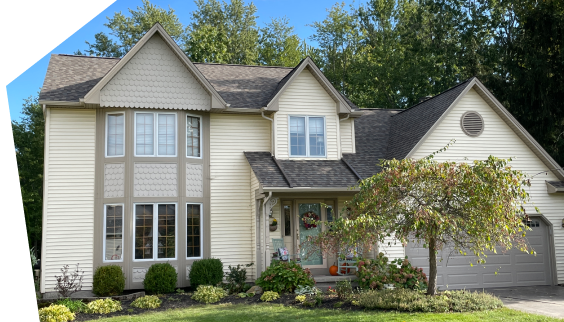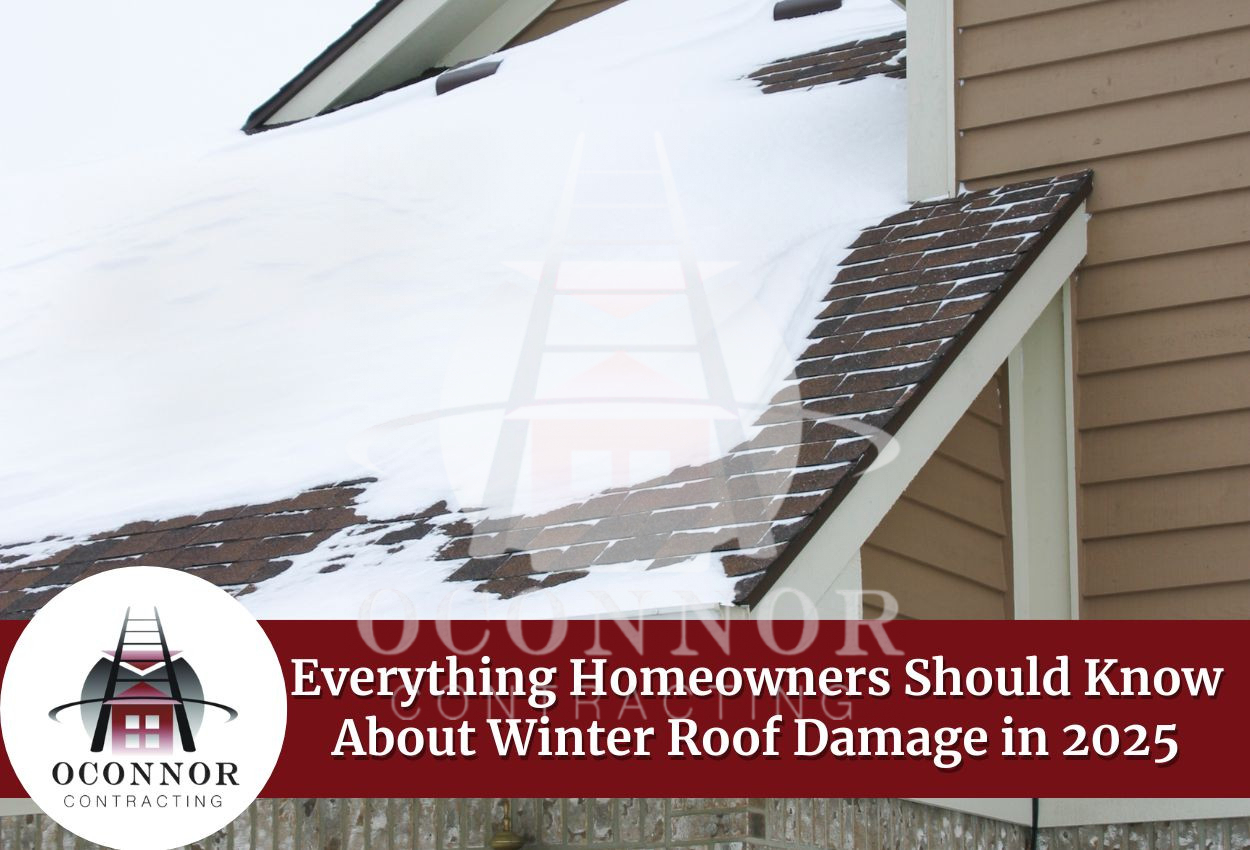While winter is loved by many, it can be a hard time for the roof of your home. As 2025 approaches, knowing about winter roof damage is more important than ever due to the effects of climate change and changing weather patterns. If a roof is ignored in the winter, it may cost the average homeowner hundreds of dollars to repair the damage so taking preventative measures is not just advised, but required.
In this blog post, we’ll cover some common types of winter roof damage, how to spot warning signs, prevention tips, and when to call a professional.
What Are The Common Causes Of Winter Roof Damage?
Winter can cause many things to go wrong with your roof. To help you get a better idea of the type of damage that occurs to a roof, we’ve created the following list:
1. Water Buildup
Rain or snow can accumulate on roofs due to poor drainage, which leads to trapped water. In winter, this water freezes and thaws repeatedly, causing cracks and leaks that worsen over time.
2. Ice Dam Formation

As snow melts and refreezes at the roof edges, it forms ice dams that block drainage. This trapped water can leak under the shingles, eventually leading to leaks inside your home.
3. The Impact of Strong Winds
Winter storms bring strong winds that can loosen shingles or blow debris, like tree branches, onto the roof. This added pressure increases the risk of roof damage
4. Snow Overload

Heavy snow can place significant weight on your roof, especially on older structures. If left unchecked, this excess weight can cause sagging or even collapse.
5. Flashing Problems
Flashing, which protects joints and seams along the roof, is vulnerable to harsh winter conditions. Damaged flashing around chimneys, vents, or skylights will lead to leaks if it’s not fixed right away.
6. Material Shifting
Winter’s fluctuating temperatures cause roofing materials to expand and contract. Over time, this movement can weaken seams and cause cracks in the roofing material.
7. Freeze-Thaw Effects
The freeze-thaw cycle can make small cracks and gaps in roofing materials worse, allowing water to seep in and cause further damage.
8. Worn-Out Materials
Roofing materials naturally wear out with age, making them more susceptible to winter’s harsh weather. This deterioration can lead to leaks and structural weakness.
9. Condensation Concerns
Without proper attic ventilation, moisture can build up beneath the roof, leading to condensation. This excess moisture can cause mold and wood rot, which compromises the roof’s structural stability
What Are The Key Signs Of Winter Roof Damage?
Knowing the signs of winter roof damage early will save you from making expensive repairs when it gets out of control. Here’s how to spot signs of winter roof damage before they worsen:
Structural Indicators
1. Sagging Rooflines
A sagging roofline is a critical sign of potential structural damage, often caused by the weight of heavy snow or ice. If this is not addressed quickly, the roof may collapse making it important to act as soon as you notice this issue.
2. Cracks or Splits in the Roof Surface
Winter conditions, such as heavy snow, ice buildup, or falling debris, can cause cracks or splits in the roof. These gaps allow moisture to enter, leading to leaks and further damage if left unchecked.
3. Pooling Water
Ice dams or blocked gutters can prevent water from draining properly, causing pooling on the roof. This stagnant water can seep under shingles and into the roof’s structure, causing long-term damage if it’s not addressed immediately.
4. Structural Movement
Shifting or movement among parts of the roof, such as misaligned materials or visible gaps, could indicate deeper structural problems. These issues are often worsened by winter weather and require immediate attention.
Interior Indicators
5. Leaks and Water Stains
Water stains or visible leaks on ceilings and walls are often the result of winter roof damage. This can happen if shingles or flashing have been compromised. Quick detection is essential to prevent mold growth and further interior damage.
6. Mold and Moisture Growth
When there’s not the right amount of attic insulation or ventilation, condensation builds up and encourages mold growth. Over time, this moisture can weaken the roofing structure, requiring timely attention to prevent more severe damage.
7. Increased Heating Bills
A sudden rise in heating costs may signal that heat is escaping through gaps in the roof or due to insufficient insulation. This not only raises energy costs but can also increase the amount of moisture, further damaging the roof.
8. Deteriorating Insulation
Wet or damaged attic insulation could indicate leaks in the roof. Moisture in the insulation reduces its effectiveness, contributing to higher energy costs and further roof deterioration.
Gutter and Drainage Issues
9. Faulty Gutters and Downspouts
If gutters are clogged or not working properly, water may back up onto the roof, leading to ice dams and leaks. Ensuring proper drainage is key to avoiding water damage from winter weather.
External Indicators
10. Damaged Shingles
Inspect for cracked, curled, or missing shingles. These are signs of wear due to harsh winter conditions and expose the roof to moisture, increasing the risk of leaks and damage.
11. Icicles on Eaves
While icicles might seem harmless, their presence often signals poor drainage and potential ice dam formation. They form when snow melts but doesn’t properly drain off the roof, leading to water buildup.
12. Visible Rust on Metal Roofs
Rust spots on metal roofs indicate corrosion caused by prolonged moisture exposure. Rust weakens the roof, making it more susceptible to leaks and other forms of damage if left untreated.
13. Flashing Damage
Check that the flashing installed around chimneys, vents, and skylights doesn’t have cracks or is starting to separate from the roof. Damaged flashing is a common area where water enters, making it crucial to repair these areas quickly to prevent leaks during winter storms.
Preventive Measures
Preventing winter roof damage is all about proactive care. Here’s what you can do to keep your home safe:
1. Keep Gutters Clean
Start by cleaning your gutters regularly throughout the year, but especially before winter weather sets in. When gutters are clogged, water can pool and freeze, leading to potential ice dams. Ensuring they are clear before winter helps water flow off the roof freely, reducing the chance of water pooling and leaks.
2. Remove Debris
Remove any debris from your roof. Leaves and branches can trap moisture, promoting mold growth and shingle damage. Clearing debris not only prevents this but also ensures your roof stays protected from leaks during winter.
3. Trim Overhanging Branches
If any trees are close to your home and roof, trim back the branches. These branches can snap under the weight of snow or ice, falling onto your roof and causing damage. Cutting them back before winter reduces the chances of this happening, protecting both your roof and your home.
4. Schedule a Roof Inspection
A professional roof inspector can identify issues like loose shingles or damaged flashing that could worsen with roof damage from winter storms. Getting these areas fixed early helps prevent bigger problems later.
5. Ensure Proper Insulation and Ventilation
Next, focus on your attic’s insulation and ventilation. Proper insulation prevents heat from escaping, while ventilation helps keep the roof cool, reducing the risk of winter damage. Together, they ensure that melting snow drains away properly without turning into an ice dam.
6. Use Safe Snow Removal
After preparing your gutters and insulation, safely remove snow from your roof when necessary. Using a roof rake helps distribute the weight of snow evenly, preventing structural stress that could lead to damage.
7. Install Gutter Guards
Installing gutter guards can further prevent winter roof damage by reducing debris buildup. These guards allow melted snow to drain efficiently, preventing ice dams and reducing maintenance. They’re a great accessory for keeping your roof safe from water buildup.
8. Monitor Ice Dams
Always keep an eye out for ice dams. If you notice snow accumulating at the roof’s edge, take action immediately with a roof rake or by installing heating cables. This helps prevent damage and keeps water from backing up into your home.
Can Heavy Snow Cause A Roof To Collapse?
Heavy snow can lead to roof collapse if the weight surpasses the structural limit of the roof. Though modern roofs are built to support snow, factors like age, weak construction, and wet, heavy snow can raise the risk. Look for signs like sagging ceilings and cracks, which indicate potential issues. Homeowners should monitor snow buildup and take action to prevent serious damage.
Get Your Roof Winter Ready with OConnor Contracting
Understanding the common types of winter roof damage and taking proactive steps to prevent them can help protect your home from expensive repairs and ensure its longevity. By maintaining your roof, you’re not only preventing damage but also creating a safe and comfortable living space, especially during the harsh winter months.
When winter storms strike, OConnor Contracting is here to help with expert roof storm damage services. We provide thorough inspections and reliable repairs, ensuring your home is safe and secure. Trust OConnor Contracting to restore your roof to its original condition, protect your home, and give you peace of mind during the harshest weather. Contact us today at (716) 600-7663.


